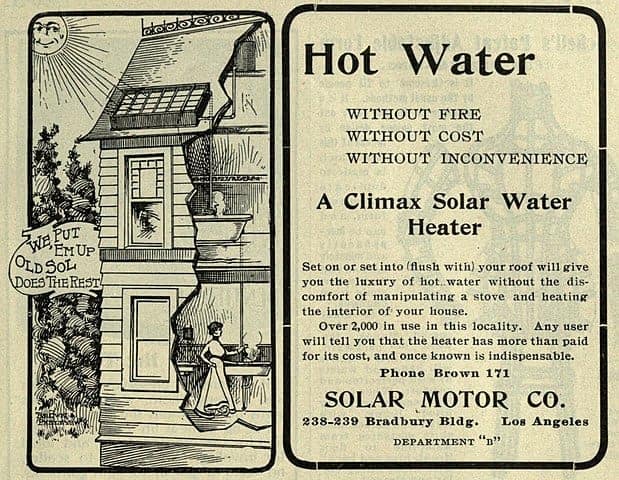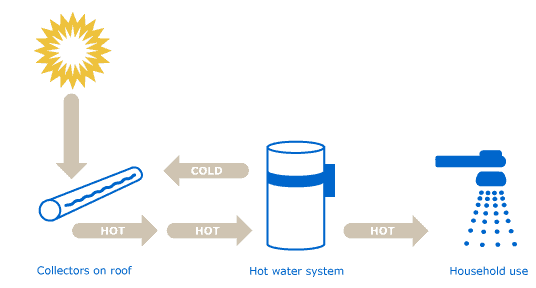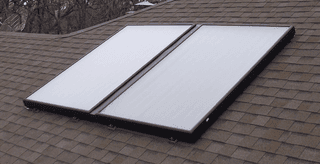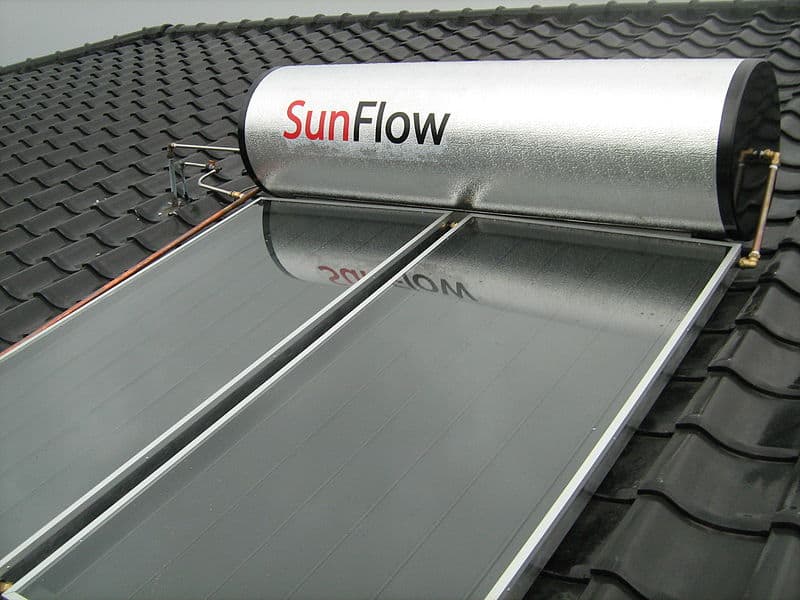Table of Contents
Solar Geyser 101: A Beginner’s Guide
Solar geysers have been around for more than a century.
The first solar water heaters were simple black-painted tanks mounted on the roof of your house.
Unfortunately, these relied entirely on the sun’s heat. That meant you could only get a hot bath on a very sunny day.

Fortunately for those of us who prefer a hot bath on a bitterly cold winter morning, solar geysers have improved since the early 1900s.
Today they produce hot water more efficiently and we’ve found a way to make them work even on a June morning.
In this post we look at:
- How a solar geyser works.
- The two main types to choose from.
- Solar geysers versus electric geysers.
- The pros and cons.
- The average price of a solar geyser in Zimbabwe and South Africa.
How does a solar geyser work?
Solar water heaters have two main components. A solar thermal collector and a storage tank.
Sunlight is absorbed by the collector which heats the water or liquid.
If water is used, it moves up to the storage tank through convection where it sits until you need it.
If a heating liquid is used, the liquid is pushed by a pump to the storage tank where the water is heated through transference.

Will I get hot water on a cloudy day?
Solar water heaters use the available sunlight to give you hot water. It will still work on an overcast day.
However, since there isn’t as much sunlight, it won’t heat the water as it would on a bright sunny day.
Most solar geysers come with a thermostat and backup electric element for this reason.
When your solar geyser doesn’t heat the water to the required temperature, the backup electric element kicks in to “top up” the heat.
The backup kicks in only where the solar isn’t getting the water hot enough.
The system is automated so you don’t have to worry about the electric element working when it shouldn’t.
Will I get hot water in winter?
Solar geysers can work almost as well in winter as in summer.
But days are shorter in winter and the starting temperature of the water is much colder.
That means the geyser has to work that much harder to produce hot water. The same is true of a conventional electric geyser.
Also, there’s more demand for hot water on cold days.
Since a solar geyser has a backup electric element, it will still give you hot water if there isn’t enough sun.
Will I get hot water at night?
The water storage tank comes with insulation.
This ensures the water heated during the day is kept hot for longer.
Again, the electric element is there as a backup to maintain the water temperature.
How hot does the water get?
Both solar and electric geysers heat water up to 60⁰C.
How long it takes varies depending on factors like the angle and tilt of the solar geyser for example.
Typically, a solar geyser will heat a 300L tank in about 4-5 hours.
Types of solar geysers
Solar water heaters use different systems. They also range in size from 100L to 300L.
The most popular and easily available types of solar geysers in Zimbabwe and South Africa are Evacuated Tube and Flat Plate Collectors.
Evacuated Tube Collectors
Evacuated tube collectors use glass tubes and rely on convection for water heated in the tubes to rise to the storage tank.
The cooler water in the tank flows down into the collector, thus circulating through the system.
Because of their tube shape as opposed to being flat, ETCs can track the sun for longer. This makes them more efficient on overcast days and in winter.

Flat Plate Collector
Flat plate collectors use a glass “oven-like” box.
The box acts like a large solar panel collecting the sun’s rays and transferring the heat using heat-transfer fluid (water or water/antifreeze mix) to an insulated hot water tank.
Flat Plate Collectors come in two designs.
The system can be completely roof mounted or split.

In a split flat plate collector, only the thermal collector is visible on the roof.

In this design, both the collector and the tank are mounted on the roof.
Which of the two systems is better? Find out in this post where we compare the different solar geyser systems.
Should you get a solar geyser?
Heating and cooling use the most electricity in a building.
Heating water takes up a significant proportion of that.
But what are the pros and cons of a solar geyser, especially if you already have an electric geyser? Let’s explore.
| Solar Geyser | Electric Geyser |
| Pros | Pros |
| Water heating can make up to 30% of your electricity bill. A solar water heater can reduce your electricity bill by between 25-35%. | Hot water whenever you want it. |
| You still get hot water even in a blackout or load shedding. | Most homes already have an electric geyser pre-installed. |
| No maintenance required. | Cons |
| You reduce your carbon footprint when you switch to solar. | Load shedding or a blackout means a cold bath. |
| Cons | More expensive to run as they add to your electricity bill. |
| High upfront cost. | Higher carbon footprint as they run only on grid-supplied electricity. |
| Not as reliable as an electric geyser on cloudy days and in winter. | As of 2019, they banned the installation of new electric geysers in Zimbabwe. |
Solar geyser FAQs
How long does a solar geyser last?
Solar geysers have a lifespan of 20 years.
How long does installation take?
Installation of a solar geyser is usually done within a day.
What's the price of a solar geyser in Zimbabwe?
On average, expect to pay between USD400 to USD1800 if you’re buying in Zimbabwe. In South Africa, they range between R5000 to R14000, excluding costs related to bringing it in to the country. All prices are exclusive of installation charges.
Conclusion
A solar geyser can be a great first step to reducing your electricity bill. It’s also a better way to heat water in the event of load shedding or a blackout.
While the initial cost of a solar water heating system can be high, the system will pay you back in savings made on your power bill within 2-5 years.
Considering it has a lifespan of 20 years, it’s well worth the investment.
Feel you’re up to speed on solar? Take our Solar 101 Quiz and find out how solar savvy you are!